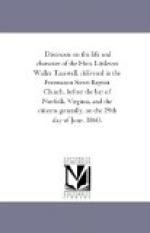About the year 1798, an eccentric individual named John Taylor, but better known as Solomon John, to distinguish him from two other persons of the same name living in Norfolk at the same time, a man of wealth and position, but believed to be slightly deranged in some respects, was returning from a hunting excursion, and, stopping at Burk’s Gardens, which have long since given way to the houses now composing Hartshorne’s Court, deliberately discharged his piece, which was loaded with small shot, at a crowd of people, and wounded a man named Rainbow in the leg, which was at length amputated. Rainbow instituted a suit, an action of trespass on the case, in the Borough Court, and filed a declaration in that form. Tazewell, as Taylor’s attorney, offered to demur to the declaration, a mode of pleading which, though old as the English law itself, was a novelty in the borough; and the Court refused to receive it. Mr. Tazewell took a bill of exceptions to the District Court at Suffolk. The point of the demurrer was that the action should have been trespass vi et armis. The District Court affirmed the decision of the Borough Court; and an appeal was taken to the Court of Appeals, which reversed the decision of the inferior courts. Until this time the distinction, which is merely technical, had been hardly perceptible to the courts of England and of this country, and was by no means settled law; but thereafter the points of difference were regarded as clearly defined; and both in England and in the courts of the United States, the case of Taylor vs. Rainbow has always been cited as conclusive of the question.
The other case, which was one of the last in which he appeared at the Virginia bar, was Long vs. Colston, and was argued in 1820, in the Court of Appeals. His associate in the case was Mr. Wickham, and the opposing counsel were Gen. Walter Jones and Mr. Stanard; and it was decided by Judges Roane, Cabell, and Coalter. The arguments of Tazewell are not stated; but Mr. Gilmer, who reports the decision, laments that no official reporter was present “to give to the profession even a sketch of the profound and comprehensive views of the counsel.” The question was on the doctrine of Covenant; and I am told by learned counsel who have examined Mr. Tazewell’s notes in the case, that this was, in their opinion, the greatest forensic display ever made in this country.
I recall an anecdote which was current at the time, and which shows the effect of Tazewell’s argument on the court. Roane, one of the judges whose reputation has been held almost sacred in Virginia, was not prejudiced in favor of Tazewell, in consequence of old political feuds; but he was so transported by his argument that he could hardly think or speak of anything else during the day. It is said that, on the day of the argument, Roane had invited a party to dine with him, and after the adjournment of the court went to his study at home, where he appeared




